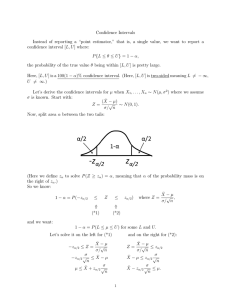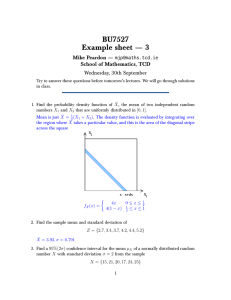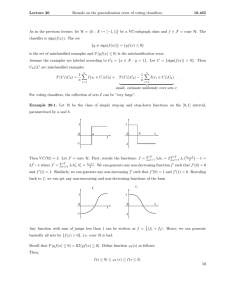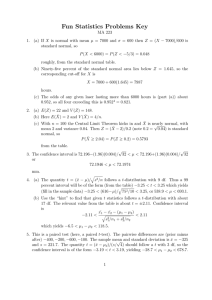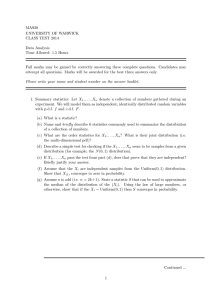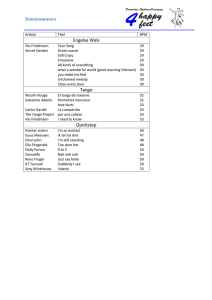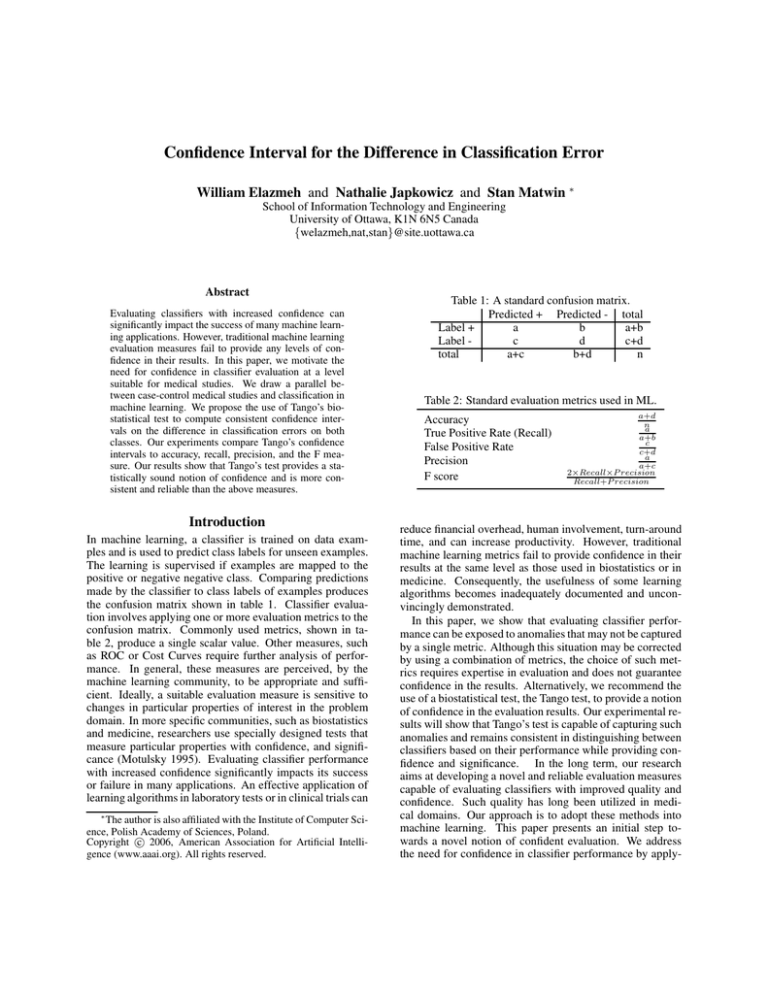
Confidence Interval for the Difference in Classification Error
William Elazmeh and Nathalie Japkowicz and Stan Matwin ∗
School of Information Technology and Engineering
University of Ottawa, K1N 6N5 Canada
{welazmeh,nat,stan}@site.uottawa.ca
Abstract
Evaluating classifiers with increased confidence can
significantly impact the success of many machine learning applications. However, traditional machine learning
evaluation measures fail to provide any levels of confidence in their results. In this paper, we motivate the
need for confidence in classifier evaluation at a level
suitable for medical studies. We draw a parallel between case-control medical studies and classification in
machine learning. We propose the use of Tango’s biostatistical test to compute consistent confidence intervals on the difference in classification errors on both
classes. Our experiments compare Tango’s confidence
intervals to accuracy, recall, precision, and the F measure. Our results show that Tango’s test provides a statistically sound notion of confidence and is more consistent and reliable than the above measures.
Introduction
In machine learning, a classifier is trained on data examples and is used to predict class labels for unseen examples.
The learning is supervised if examples are mapped to the
positive or negative negative class. Comparing predictions
made by the classifier to class labels of examples produces
the confusion matrix shown in table 1. Classifier evaluation involves applying one or more evaluation metrics to the
confusion matrix. Commonly used metrics, shown in table 2, produce a single scalar value. Other measures, such
as ROC or Cost Curves require further analysis of performance. In general, these measures are perceived, by the
machine learning community, to be appropriate and sufficient. Ideally, a suitable evaluation measure is sensitive to
changes in particular properties of interest in the problem
domain. In more specific communities, such as biostatistics
and medicine, researchers use specially designed tests that
measure particular properties with confidence, and significance (Motulsky 1995). Evaluating classifier performance
with increased confidence significantly impacts its success
or failure in many applications. An effective application of
learning algorithms in laboratory tests or in clinical trials can
∗
The author is also affiliated with the Institute of Computer Science, Polish Academy of Sciences, Poland.
c 2006, American Association for Artificial IntelliCopyright gence (www.aaai.org). All rights reserved.
Table 1: A standard confusion matrix.
Predicted + Predicted - total
Label +
a
b
a+b
Label c
d
c+d
total
a+c
b+d
n
Table 2: Standard evaluation metrics used in ML.
Accuracy
True Positive Rate (Recall)
False Positive Rate
Precision
F score
a+d
n
a
a+b
c
c+d
a
a+c
2×Recall×P recision
Recall+P recision
reduce financial overhead, human involvement, turn-around
time, and can increase productivity. However, traditional
machine learning metrics fail to provide confidence in their
results at the same level as those used in biostatistics or in
medicine. Consequently, the usefulness of some learning
algorithms becomes inadequately documented and unconvincingly demonstrated.
In this paper, we show that evaluating classifier performance can be exposed to anomalies that may not be captured
by a single metric. Although this situation may be corrected
by using a combination of metrics, the choice of such metrics requires expertise in evaluation and does not guarantee
confidence in the results. Alternatively, we recommend the
use of a biostatistical test, the Tango test, to provide a notion
of confidence in the evaluation results. Our experimental results will show that Tango’s test is capable of capturing such
anomalies and remains consistent in distinguishing between
classifiers based on their performance while providing confidence and significance. In the long term, our research
aims at developing a novel and reliable evaluation measures
capable of evaluating classifiers with improved quality and
confidence. Such quality has long been utilized in medical domains. Our approach is to adopt these methods into
machine learning. This paper presents an initial step towards a novel notion of confident evaluation. We address
the need for confidence in classifier performance by apply-
ing a confidence test. Experimentally, we show that Tango’s
test (Tango 1998) is capable, reliable and consistent in comparison to accuracy, recall, precision, and F scores. In future
work we plan to compare our evaluation method to more sophisticated evaluation measure, such as ROC curves, AUC,
and Cost curves. After the introduction, we review work
related to classifier evaluation and draw a parallel between
case-control studies and classification. In subsequent sections, we present the experimental results and a discussion
followed by conclusions and future work.
Related Work
Classifier performance is measured by estimating the accuracy of the learned hypothesis. Estimating hypothesis accuracy with the presence of plentiful data is simple, however, evaluating a hypothesis for future data with the presence of limited data is faced with two challenges defined
as Bias and Variance (Mitchell 1997). The objective is
to estimate the accuracy with which a classifier will classify future instances while computing the probable error of
this accuracy estimate. In theory, Mitchell (Mitchell 1997)
presents methods to evaluate a learned hypothesis, to compare the accuracy of two hypothesis, and to compare the accuracy of two learning algorithms in the presence of limited data. The model is based on basic principles from
statistics and sampling theory. In practice, the predictive
ability of a classifier is measured by its predictive accuracy (or the error rate) computed on the testing examples
(Ling, Huang, & Zang 2003) which, in many cases, has been
shown to be insufficient (Ling, Huang, & Zang 2003) or inappropriate (Provost & Fawcett 1997). Performance metrics, in table 2, are commonly used to produce a ranking
of classifiers. Alternatively, the ROC (Receiver Operating
Characteristics) analysis (Cohen, Schapire, & Singer 1999;
Provost & Fawcett 1997; Swets 1988) are used to visualize relative classifier performance to determine the “best”
classifier based on comparing the rate of correctly classified
positive examples to the rate of incorrectly classified positive examples for a particular class. The AUC (Area under the ROC Curve) (Ling, Huang, & Zang 2003; Caruana
& Niculescu-Mizil 2004) produces a single scalar measure
to rank classifiers based on how they dominate each other.
The ROC curves are shown to be insensitive to the cost of
classification (the penalty of miss-classification), therefore,
Cost Curves were proposed in (Drummond & Holte 2000;
2004) to introduce costs as a factor in comparing the performance of classifiers.
The above measures fail to answer the question, addressed
in (Goutte & Gaussier 2005): given a classifier and its results on a particular collection of data, how confident are
we on the computed precision, recall, or F-score? The
work in (Goutte & Gaussier 2005) presents a probabilistic interpretation of precision, recall, and F-score to compare performance scores produced by two information retrieval systems. In this case, such work remains probabilistic and makes several assumptions of probability distributions. (Yeh 2000) reports; when comparing differences
in values of metrics like Recall, Precision, or balanced Fscore, many commonly used statistical significance tests un-
Table 3: Marijuana users/non-users and matched controls
with (+) or without (-) sleeping difficulties.
user (+)
user (-)
total
non-user (+)
4
9
13
non-user (-)
3
16
19
total
7
25
32
derestimate the differences of their results. (Drummond &
Holte 2004) derived confidence intervals to show statistical significance on cost curves by means of sampling and
re-sampling. The method is data driven without making
any parametric assumptions, e.g. probability distribution assumptions. The sampling method in (Margineantu & Dietterich 2000) use bootstrap methods (Efron & Tibshirani
1993) to generate confidence intervals for classification cost
values. These methods may produce confidence level for the
evaluation, however, computing confidence intervals that are
narrow, reliable and robust is not a simple task (Motulsky
1995). (Newcombe 1998a) shows that the underlying statistical method of Tango’s produces more reliable and consistent confidence intervals with good coverage probability.
Thus, we expect Tango to out perform any bootstrapping
methods (Newcombe 1998a). Comparing these with Tango
remains a future work item. In this work, we use the Tango’s
test to detect if a classifier that produces confident results or
not, rather than compute confidence intervals on the results.
Case-control Studies and Classification
A case-control study is a medical study to measure the relationship between the exposure to a specific risk factor and
the development of a particular disease. The approach is
to compare the distributions of patient groups who do develop the disease to those who do not. Such studies can
be conducted by clinical trials where groups of patients are
exposed to the risk factor and their development of the disease is monitored. However, clinical trials are costly, they
are difficult to design, and their resulting distributions of
disease development are based on exposure. Alternatively,
a case-control study examines exposure history of patients
who do or do not develop the disease. Supposedly, patients
in the control group are similar to those in the cases group
with the absence of the diseases, i.e. individual cases of
the disease are matched with individual controls based on
a set of attributes, e.g. age, gender, location, etc. (Motulsky 1995). The study becomes stronger when the analysis takes into consideration this paired matching. For
example, consider the control-case study in (Tango 1998;
Karacan, Fernandez, & Coggins 1976; Altman 1991) of 32
marijuana users matched with 32 controls with respect to
their sleeping difficulties shown in table 3. The subjects
are matched based on a set of relevant variables (age, location, etc.) Each entry in table 3 is a number of pairs
(control and case pairs) where 4 matched pairs of marijuana
users and controls experienced sleeping difficulties, 9 controls experienced sleeping difficulties while their matched
marijuana users did not experience sleeping difficulties, 3
controls did not experience sleeping difficulties while their
matching marijuana users did, and 16 pairs of marijuana
users and control subjects (non-users) did not experience
sleeping difficulties.
In this study, the interest lies in the statistical significance
for the difference in proportions experiencing sleeping difficulties. The two diagonal entries in Table 3 (entries a and
d in table 1), medically and statistically, provide no information with respect to the difference between sleeping difficulties and exposure to marijuana (Newcombe 1998a). The
results of sleeping difficulty in both entries are the same for
both users and non-users of marijuana. However, the two
off-diagonal entries (exposed controls that are not cases of
sleeping difficulties and non-exposed controls that are cases
of sleeping difficulties – entries b and c of table 1) are relevant to the association between sleeping difficulties and the
exposure to marijuana. (Tango 1998) computes the 1-α confidence intervals for this normalized difference b−c
n in these
proportions (n is the total number of cases and controls). For
the above example, Tango’s produces the 95%-confidence
interval of [−0.02709, 0.38970]. By definition, the confidence intervals produce the plausible values of the difference in proportions. Since the value 0 is inside the confidence interval, then with 95% confidence it can be stated
that the difference b−c
n may have a plausible value of zero
and that the two groups (users and non-users of marijuana)
exhibit sleeping difficulties with no statistically significant
difference. Therefore in the above example, the observed
difference is 9−3
32 = 18.75% is insignificant. Tango’s test is
presented in (Tango 1998) and is described in more details
in appendix A.
At this point, it is important to draw a parallel to classification in machine learning where a classifier is trained
on labeled examples and is tested on unseen labeled examples. Classifier evaluation involves estimating to what extent, if any, the resulting classifier is capable of predicting
the class labels of the unseen instances. In the context of
the above control-studies, the issue is measuring the difference between distributions of classifier predictions and class
labels. On way to assess this ability is to measure the difference in error proportions between instance labels and classifier predictions by using Tango’s test. In other words, when
taking the case-control approach to classification, testing examples undergo two classifications, labels and predictions.
The two classifications may produce identical labels (true
positives or true negatives) and/or different labels (false positives and false negatives). The issue of evaluation becomes:
at a particular level of confidence (95%), is there a statistically significant difference between the error proportions
of classifications. This is parallel to analyzing the error difference of exhibiting sleeping difficulties between users and
non-users of marijuana. In this context, this method can
evaluate binary classifiers where the positive class is a positive indication of the presence of a particular disease or a
particular condition.
Experimental results
This section presents our experimental design with a brief
review of our data sets followed by a discussion of our ex-
Table 4: UCI datasets used and their class distributions.
#
1
2
3
4
5
6
7
8
9
10
11
12
Dataset
WPBC
WBCD
Pima Diabetes
Echocardiogram
Hepatitis
Hypothyroid
WDBC
Thyroid (euthy.)
Thyroid (dis)
Thyroid (sick)
SPECT
SPECTF
Attr.
34
11
9
13
20
26
31
26
30
30
23
45
Train +/151/47
458/241
500/268
50/24
32/123
151/3012
212/357
293/2870
45/2755
171/2629
40/40
40/40
Test +/c. valid.10
c. valid.10
c. valid.10
c. valid.10
c. valid.10
c. valid.10
c. valid.10
c. valid.10
13/959
60/912
15/172
55/214
perimental results. The objective is to compare the performance of four classifiers reported by accuracy, recall (true
positive rate), false positive rate, precision, and F measures
to that reported by Tango. We use Tango’s confidence intervals to measure the significance of the difference in error
fractions b−c
n between predictions made by the four classifiers and class labels at the 95%-confidence level. Thus, a
classifier is considered 95%-confident (✔) when its corresponding Tango’s 95%-confidence interval includes the zero
value. Otherwise, the observed difference is deemed statistically insignificant. Using the Weka 3.4.6 software (Witten & Frank 2005) on our datasets, we build four classifiers;
a decision stump (S), a decision tree (T), a random forest (F),
and a Naive Bayes (B). The rationale is to build classifiers
for which we can expect a ranking of their relative performance. A decision stump built without boosting is a decision
tree with one test at the root (only 2 leaf nodes) and is expected to perform particularly worse than the decision tree.
Relatively, a decision tree is a stronger classifier because its
tree is more developed and has more leaf nodes which cover
the training examples. In theory, multiple tests on the data
should produce a classifier better than performing a single
test. The random forest classifier is a reliable classifier and
is expected to outperform a single decision tree. Finally, the
naive Bayes tends to minimize classification error and is expected to perform well when trained on balanced data.
Our data sets, listed in table 4, are selected from the UCI
Machine Learning repository (Newman et al. 1998). The
data consists of records that describe characteristics of a
class in a two class problem (positive and negative). The
data sets are grouped into three groups based on their class
distributions of positive and negative examples. The first
two groups have no testing examples, therefore, we use
cross-validation test method of 10 folds. The third group
of data sets has test sets that are severely imbalanced. The
experimental results are presented in two tables. Table 5
presents the performance of our classifiers on our data sets
as evaluated by the Accuracy (Acc.), Recall (Rec.) or true
positive rate, Precision (Prec.), and F score. The table also
shows which classifiers are found to be confident by Tango
(indicated by ✔). Table 6 shows the performance evaluation
of the same classifiers on the same data sets as measured
by Tango’s 95%-confidence intervals. The table also shows
the entries to each of the confusion matrices (a, b, c, d as described in table 1) along with the observed b−c
n .
Consider the evaluation results in both tables for data set
#1. We observe that (S) shows very good performance values in table 5. This is contradicted by Tango in table 6 where
(S) shows the widest confidence intervals with a significant
observed difference. We examine the corresponding confusion matrix (a, b, c, d entries in table 6) to see that (S) predicts a positive class for all examples (b = d = 0). This
is a situation that cannot be captured from table 5, unless,
one considers the FP rate because it is related to the a poor
performance on the negative class. On the same data set, (B)
shows a much less FP rate with significantly lower scores in
table 5. This is due to its error on both classes (both b and
c are higher). Alternatively, Tango, in table 6, indicates that
(T) is the confident classifier. When we consider the confusion matrices shown in table 6, we see that Tango’s test
detects significant increases in classification errors on either
one of the two classes (when either b or c is significantly
higher). In fact, Tango’s test is designed to favor those classifiers that have lower classification errors in both classes.
This criteria imposes accuracy constraints that prevents classifiers such as (S) from obtaining high evaluation ranks.
For data sets #5 and #9, consider the confusion matrices
(entries a, b, c, d in table 6) of all four classifiers. If we coma
d
and c+d
, we see that all claspare their corresponding a+b
sifiers perform significantly better on the negative class than
on the positive class. In table 5, their accuracies remains
high. Their FP rates, recall, precision, and F scores are relatively low. Accuracy, in this case, is inappropriate due to
the significantly higher number of negative examples while
recall, precision, and F scores are computed for the positive
class only. In fact, Tango finds that (B) on set #5 and (T)
on set # 9 produce reliable classifiers that have the least observed b−c
n difference. Their corresponding F scores are the
highest on each set respectively. Furthermore, accuracy can
be inappropriate in other circumstances. For instance, consider data set #9. The performance of classifier (S) is vary
poor in table 5, yet its accuracy remains high. When looking
at the same row in table 6, we see that (S) classified all instances in the negative class but due to the severe imbalance,
the accuracy on the negative class becomes sufficient for (S)
to obtain a high accuracy score.
On data sets # 2, 4, 6, 7, 8, and 10, we see that most of
the scores in table 5 are relatively high, in particular, the F
scores. In addition, the highest F scores of classifiers, in
each set in this group, are found to be confident by Tango.
If we consider the confusion matrices for these classifiers on
these sets in table 6, we see that most of them perform well
on both classes and their errors (b and c) are low. We can
see that Tango favors those classifiers that produces lower
values of error on both classes. Furthermore, Tango’s loses
confidence in those classifiers that produce a significant error on only one of the two classes. This loss of confidence
appears to correspond with lower F scores in table 5. However, the values of those confident F scores appears to vary
for different data sets. For example, an F score of 80.2% for
(T) on set # 3 is confident but 86.2% F score is not confident
for (F) on data set # 10. In addition, on data set # 2, (T) has a
confident F score of 95.7% while (B) has 98% F score with
no confidence. This is explained by comparing their corresponding b − c values shown in table 6. Tango produces
more confidence for classifier with lower b−c
n values.
Conclusions and Future work
A conclusive observation is that Tango shows a consistent
confidence with lower values of b−c
n (in the absolute value)
which favors lower errors on both classes. The accuracy can
possibly be misleading or inappropriate. Recall alone is insufficient and must take into account precision. The FP rate
is helpful when combined with some other metric (e.g. recall). However, the question remains: for evaluation, which
metric should one consider? The answer is not necessarily obvious and requires an extensive understanding of the
metric and its shortcomings. The F score alone is not sufficient (data set #1). In this work, we propose using Tango’s
test to assess classification errors on both classes. Our experiments show that standard machine learning evaluation
metrics, namely, accuracy, recall, false positive rate, precision, and F score are unable to single-handedly provide
confidence in their evaluation results. Tango provides a consistent notion of confidence in the form of statistically sound
confidence intervals on the difference in classification error.
Our subsequent work will extend our comparisons to include
ROC curves and cost curves in search for an improved and
confident evaluation measure for supervised, and possibly
for unsupervised, classification.
Acknowledgments
The authors thank James D. Malley at the National Institute
of Health for his suggestions and communications. In addition, we acknowledge the support of The Natural Sciences
and Engineering Research Council of Canada (NSERC).
References
Altman, D. G. 1991. Practical Statistics for Medical Research. Chapman-Hall.
Caruana, R., and Niculescu-Mizil, A. 2004. An empirical evaluation of supervised learning for roc area. The 1st
Workshop on ROC Analysis in AI, ECI 2004 1–8.
Cohen, W. W.; Schapire, R. E.; and Singer, Y. 1999. Learning to order things. Journal of Artificial Intelligence Research (10):243–270.
Dietterich, T. G. 1998. Approximate statistical test for
comparing supervised classification learning algorithms.
Neural Computations 10(7):1895–1923.
Drummond, C., and Holte, R. C. 2000. Explicitly representing expected cost: An alternative to roc representation.
The Sixth ACM SIGKDD Int. Conf. on Knowledge Discovery and Data Mining 198–207.
Drummond, C., and Holte, R. C. 2004. What ROC curves
can’t do (and cost curves can). Workshop on ROC Analysis
in AI, ECAI 2004.
Table 5: Accuracy (Acc.), Recall (Rec.), FP rate, Precision
(Prec.), and F-score for C = decision stump (S), decision
tree (T), random forest (F), or naive Bayes (B) on data sets
# (table 4). Confident classifiers by Tango are ✔.
#
1
2
3
4
5
6
7
8
9
10
11
12
C
S
T
F
B
S
T
F
B
S
T
F
B
S
T
F
B
S
T
F
B
S
T
F
B
S
T
F
B
S
T
F
B
S
S
F
B
S
T
F
B
S
T
F
B
S
T
F
B
Acc.
76.3
75.8
79.3
67.2
88.3
94.4
96.0
97.4
71.9
73.8
72.5
76.3
94.6
96.0
100
94.6
77.4
83.9
83.2
84.5
97.4
99.2
99.0
97.9
88.9
93.2
95.1
93.0
94.4
97.9
97.9
84.4
98.7
98.3
98.6
94.3
96.0
98.8
98.5
93.5
61.5
75.4
76.5
74.9
66.9
77.3
78.8
74.0
Rec.
100
85.4
96.7
71.5
83.0
95.4
96.5
96.7
79.6
81.4
83.6
84.4
96.0
98.0
100
98.0
6.3
43.8
37.5
68.8
94.7
91.4
88.7
77.5
77.8
92.5
93.4
89.6
92.2
87.0
87.7
89.8
0.0
23.1
7.7
30.8
95.0
86.7
78.3
73.3
86.7
73.3
80.0
66.7
85.5
85.5
92.7
92.7
FP Rate
100
55.3
76.6
46.8
1.7
7.5
5.0
1.2
42.5
40.3
48.1
38.8
8.3
8.3
0.0
12.5
4.1
5.7
4.9
11.4
2.5
0.4
0.5
1.1
4.5
6.4
3.9
5.0
5.3
1.0
1.1
16.2
0.0
0.7
0.2
4.8
3.9
0.4
0.2
5.2
40.7
24.4
23.8
24.4
37.9
24.8
24.8
30.8
Prec.
76.3
83.2
80.2
83.1
99.0
96.0
97.4
99.3
77.7
79
76.4
80.2
96.0
96.1
100
94.2
28.6
66.7
66.7
61.1
65.6
92.6
90.5
78.5
91.2
89.5
93.4
91.3
63.8
89.8
89.2
36.1
0.0
30.0
33.3
8.0
61.3
92.9
95.9
48.4
15.7
20.8
22.6
19.2
36.7
47.0
49.0
43.6
F
86.5
84.3
87.7
76.9
90.3
95.7
96.9
98.0
78.7
80.2
79.8
82.3
96.0
97.0
100
96.1
10.3
52.8
48.0
64.7
77.5
92.0
89.6
78.0
84.0
91.0
93.4
90.5
75.4
88.4
88.5
51.5
0.0
26.1
12.5
12.7
74.5
89.7
86.2
58.3
26.5
32.4
35.3
29.9
51.4
60.6
64.2
59.3
Tango
✔
✔
✔
✔
✔
✔
✔
✔
✔
✔
Table 6: Tango’s 95%-Confidence Intervals and b−c
n for C
= decision stump (S), decision tree (T), random forest (F),
or naive Bayes (B) on data sets # (table 4). (a,b,c,d) is a
confusion matrix. Confident classifiers by Tango are ✔.
#
1
2
3
4
5
✔
✔
✔
✔
✔
✔
✔
✔
✔
✔
✔
6
7
8
9
10
11
12
C
S
T
F
B
S
T
F
B
S
T
F
B
S
T
F
B
S
T
F
B
S
T
F
B
S
T
F
B
S
T
F
B
S
S
F
B
S
T
F
B
S
T
F
B
S
T
F
B
(a,b,c,d)
(151,0,47,0)
(129,22,26,21)
(146,5,36,11)
(108,43,22,25)
(380,78,4,237)
(437,21,18,223)
(442,16,12,229)
(443,15,3,238)
(398,102,114,154)
(407,93,108,160)
(418,82,129,139)
(422,78,104,164)
(48,2,2,22)
(49,1,2,22)
(50,0,0,24)
(49,1,3,21)
(2,30,5,118)
(14,18,7,116)
(12,20,6,117)
(22,10,14,109)
(143,8,75,2937)
(138,13,11,3001)
(134,17,14,2998)
(117,34,32,2980)
(165,47,16,341)
(196,16,23,334)
(198,14,14,343)
(190,22,18,339)
(270,23,153,2717)
(255,38,29,2841)
(257,36,31,2839)
(263,30,465,2405)
(0,13,0,959)
(3,10,7,952)
(1,12,2,957)
(4,9,46,913)
(57,3,36,876)
(52,8,4,908)
(47,13,2,910)
(44,16,47,865)
(13,2,70,102)
(11,4,42,130)
(12,3,41,131)
(10,5,42,130)
(47,8,81,133)
(47,8,53,161)
(51,4,53,161)
(51,4,66,148)
Tango’s CI
[-30.1,-18.4]
[-9.0,5.0]
[-22.0,-9.9]
[ 2.7,18.5]
[8.3,13.2]
[-1.4, 2.3]
[-1.0, 2.2]
[0.6, 3.1]
[-5.3, 2.2]
[-5.6, 1.7]
[-9.8,-2.4]
[-6.9, 0.1]
[ -7.1,7.1]
[ -8.2,4.9]
[ -4.9,4.9]
[-10.1,3.8]
[ 9.3,23.6]
[ 0.8,13.8]
[ 2.8,15.9]
[-9.2, 3.8]
[-2.7,-1.6]
[-0.3, 0.4]
[-0.3, 0.5]
[-0.5, 0.6]
[ 2.8,8.3]
[-3.5,1.0]
[-1.9,1.9]
[-1.5,3.0]
[ -5.0, -3.3]
[ -0.2, 0.8]
[ -0.4, 0.7]
[-15.1,-12.5]
[ 0.8, 2.3]
[-0.6, 1.3]
[ 0.3, 2.0]
[-5.4,-2.4]
[-4.8,-2.3]
[-0.3, 1.3]
[ 0.4, 2.1]
[-4.9,-1.6]
[-43.7,-29.3]
[-27.2,-14.1]
[-27.1,-14.3]
[-26.7,-13.4]
[-33.3,-21.2]
[-22.3,-11.6]
[-23.6,-13.4]
[-28.8,-17.8]
b−c
n
-23.7
-2.0
-15.7
10.6
10.6
0.4
0.6
1.7
-1.6
-2.0
-6.1
-3.4
0.0
-1.4
0.0
-2.7
16.1
7.1
9.0
-2.6
-2.1
0.1
0.1
0.1
5.5
-1.2
0.0
0.7
-4.1
0.3
0.2
-13.8
1.3
0.3
1.0
-3.8
-3.4
0.4
1.1
-3.2
-36.4
-20.3
-20.3
-19.8
-27.1
-16.7
-18.2
-23.1
✔
✔
✔
✔
✔
✔
✔
✔
✔
✔
✔
✔
✔
✔
✔
✔
✔
✔
✔
✔
✔
Efron, B., and Tibshirani, R. 1993. An Introduction to the
Bootstrap. Chapman-Hall.
Everitt, B. S. 1992. The analysis of contingency tables.
Chapman-Hall.
Goutte, C., and Gaussier, E. 2005. A probabilistic interpretation of precision, recall and f-score, with implication
for evaluation. The 27th European Conf. on Information
Retrieval, ECIR 345–359.
Karacan, I.; Fernandez, S. A.; and Coggins, W. S. 1976.
Sleep electrocephalographic-electrooculographic characteristics of chronic marijuana users: part 1. The New York
Academy of Science (282):348–374.
Ling, C. X.; Huang, J.; and Zang, H. 2003. Auc: a better
measure than accuracy in comparing learning algorithms.
The Canadian Conf. on AI 329–341.
Margineantu, D. D., and Dietterich, T. G. 2000. Bootstrap
methods for the cost-sensitive evaluation of classifiers. The
17th Int. Conf. on Machine Learning 582–590.
Mitchell, T. M. 1997. Machine Learning. McGraw-Hill.
Motulsky, H. 1995. Intuitive Biostatistics. Oxford U. Press.
Newcombe, R. G. 1998a. Improved confidence intervals
for the difference between binomial proportions based on
paired data. Statistics in Medicine 17:2635–2650.
Newcombe, R. G. 1998b. Two-sided confidence intervals
for the single proportion: comparison of seven methods.
Statistics in Medicine 17:857–872.
Newman, D. J.; Hettich, S.; Blake, C. L.; and Merz,
C. J.
1998.
UCI machine learning repository.
http://www.ics.uci.edu/∼mlearn/MLRepository.html. University of California.
Provost, F., and Fawcett, T. 1997. Analysis and visualization f classifier performance: Comparison under imprecise
class and cost distributions. The 3rd Int. Conf. on Knowledge Discovery and Data Mining 34–48.
Swets, J. 1988. Measuring the accuracy of diagnostic systems. The Journal of Science (240):1285–1293.
Tango, T. 1998. Equivalence test and confidence interval
for the difference in proportions for the paired-sample design. Statistics in Medicine 17:891–908.
Witten, I. H., and Frank, E. 2005. Data Mining: Practical
machine learning tools and techniques. M. Kaufmann.
Yeh, A. 2000. More accurate tests for the statistical significance of result differences. The 18th conf. on Computational Linguistics 2:947 – 953.
Appendix A: Tango’s Confidence Intervals
Clinical trials, case-control studies, and sensitivity comparisons of two laboratory tests are examples of medical studies
that deal with the difference of two proportions in a paired
design. (Tango 1998) builds a model to derive a one-sided
test for equivalence of two proportions. Medical equivalence
is defined as no more than 100Δ percent inferior, where
Δ(> 0) is a pre-specified acceptable difference. Tango’s
test also derives a score-based confidence interval for the difference of binomial proportions in paired data. Statisticians
have long been concerned with the limitations of hypothesis
testing used to summarize data (Newcombe 1998b). Medical statisticians prefer the use of confidence intervals rather
than p-values to present results. Confidence intervals have
the advantage of being close to the data and on the same
scale of measurement, whereas p-values are a probabilistic
abstraction. Confidence intervals are usually interpreted as
margin of errors because they provide magnitude and precision. A method deriving confidence intervals must be a priori reasonable (justified derivation and coverage probability)
with respect to the data (Newcombe 1998b).
The McNemar test is introduced in (Everitt 1992) and has
been used to rank the performance of classifiers in (Dietterich 1998). Although inconclusive, the study showed that
the McNemar test has low Type I error with high power (the
ability to detect algorithm differences when they do exist).
For algorithms that can be executed only once, the McNemar
test is the only test that produced an acceptable Type I error
(Dietterich 1998). Despite Tango’s test being an equivalence
test, setting the minimum acceptable difference Δ to zero
produces an identical test to the McNemar test with strong
power and coverage probability (Tango 1998). In this work,
we use Tango’s test to compute confidence intervals on the
difference in classification errors in both classes with a minimum acceptable difference Δ = 0 at the (1-α) confidence
level. Tango must make few assumptions. (1) the data points
are representative of the class. (2) The predictions are reasonably correlated with class labels. This means that the
misclassified positives and negatives are relatively smaller
than the correctly classified positives and negatives respectively. In other words, the classifier does reasonable well on
both classes, rather than performing a random classification.
Entries a and d (in table 1) are the informative or the discordant pairs indicating the agreement portion (q11 + q22 ),
while b and c are the uninformative or concordant pairs representing the proportion of disagreement (q12 + q21 ) (Newcombe 1998a). The magnitude of the difference δ in classifications errors can be measured by testing the null hypothesis
H0 : δ = q12 − q21 = 0. This magnitude is conditional on
the observed split of b and c (Newcombe 1998a). The null
hypothesis H0 is tested against the alternative H1 : δ = 0.
Tango’s test derives a simple asymptotic (1-α)-confidence
interval for the difference δ and is shown to have good
power and coverage probability. Tango’s confidence intervals can be computed by: √ b−c−nδ
= ±Z α2 where
n(2qˆ
21 +δ(1−δ))
Z α2 denotes the upper α2 -quantile of the normal distribution.
In addition, qˆ21 can be estimated
√ by the maximum likeliW 2 −8n(−cδ(1−δ))−W
where
hood estimator for q21 : qˆ21 =
4n
W = −b − c + (2n − b + c)δ. Statistical hypothesis testing begins with a null hypothesis and searches for sufficient
evidence to reject that null hypothesis. The null hypothesis
states that there is no difference (δ = 0). By definition, a
confidence interval includes plausible values of the null hypothesis. Thus, if zero is not in the interval, then δ = 0 is
rejected. If zero is in the interval, then there is no sufficient
evidence to reject δ = 0, and the conclusion is that the difference can be of any value within the confidence interval at
the specified level of confidence (1-α).

